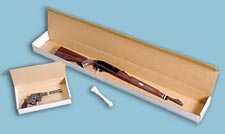- 01: Introduction
- 02: History
- 03: Propellants, Firearms, and Ammunition Development
- 04: Modern Firearms Manufacture
- 05: Small Arms Ammunition
- 06: Evidence Handling Procedures
- Introduction
- Objectives
- AFTE Knowledge and Ability Factors
- Types of Evidence
- Associative Evidence
- The Crime Scene
- Evidence Submission
- Laboratory Evidence Handling
- Case Tracking Within the Laboratory
- Firearm and Toolmark Examination Considerations
- Selected Bibliography
- 07: Equipment and Instrumentation
- 08: Examination of Firearms
- 09: Cartridge and Shotshell Examination
- 10: Characterization and Evaluation of Fired Projectiles
- 11: Bullet Comparison and Identification
- 12: Gunshot Residue and Distance Determination
- 13: Toolmark Identification
- 14: Communicating Results
- Resources


Firearms Evidence
Home > Evidence Handling Procedures > The Crime Scene > Collection of Evidence > Firearms Evidence
The collection of firearms includes the firearm, ammunition, and associated materials, such as clothing with gunshot residue deposits.
Firearms
Firearms should be unloaded and placed in a safe condition at the point of collection. If the collector is unsure of the proper procedure, assistance should be sought from a competent source such as a firearms instructor, departmental armorer, or an on-site firearm examiner.
The firearm should be identified at a minimum with the information required by the agency’s crime scene search protocols. If agency protocols mandate the direct marking of evidence, the firearm should be marked inconspicuously. One method is to inscribe the collector’s initials and other required information within the trigger guard of the firearm. A diamond or tungsten-tipped machinist’s scribing tool is frequently used for this purpose. Laboratory protocols should be followed for firearms recovered from water since special handling may be required.

Firearms packaging
Collected firearms should be packaged according to laboratory or agency policy, for example by sealing in unused wrapping paper and placing in a cardboard box designed for either handguns or shoulder arms. Unloaded ammunition may be packaged separately, marked, and identified as to the firearm from which it was removed.




